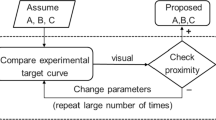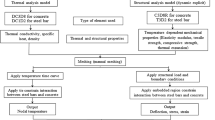Abstract
Fire accidents are significant disasters that create massive damage to buildings and other concrete structures. Generally, concrete offers good resistance against fire due to its non-flammable, low thermal conductivity and acts as a protective cover to the steel reinforcement up to certain conditions. However, high temperatures significantly affect the performance of concrete structures. For this reason, in the present study, all the structural elements (beam, column and slab) are subjected to a temperature of 593 ºC for 2 h (condition given in ANSYS software). Moreover, fire effect on the beam, columns with different cover sizes, and slabs with various thicknesses at elevated temperatures have been studied through 3D nonlinear transient thermomechanical finite element analysis. The change in cover and thickness of structural elements has a significant influence on thermal stress. Moreover, increasing every 5 mm cover in beams enriches 0.7% thermal stress resistivity and a raise of 3.5% thermal stress resistivity was noticed with the addition of every 10 mm cover size in columns. Similarly, 11.2% of thermal stress resistivity rise was observed at every 25 mm addition of slab thickness.









Similar content being viewed by others
References
Allam SM, Elbakry HM, Rabeai AG (2013) Behavior of one-way reinforced concrete slabs subjected to fire. Alex Eng J 52(4):749–761
Jiang J, Chen L, Jiang S, Li GQ, Usmani A (2015) Fire safety assessment of super-tall buildings: a case study on Shanghai Tower. Case Stud Fire Saf 4:28–38
Jiang J, Chen L, Jiang S, Li GQ, Usmani A (2015) Fire safety assessment of super tall buildings: a case study on Shanghai Tower. Case Stud Fire Saf 4:28–38
Xin J, Huang C (2013) Fire risk analysis of residential buildings based on scenario clusters and its application in fire risk management. Fire Saf J 62:72–78
Lineham SA, Thomson D, Bartlett AI, Bisby LA, Hadden RM (2016) Structural response of fire-exposed cross-laminated timber beams under sustained loads. Fire Saf J 85:23–34
George F, Balaji MA, Raj MA (2015) Fire resistant analysis of t-beam and l-beam. Int J Eng Res Gen Sci 3(4):1148–1155
Ghali YA, Sugumar R, Musa HA (2015) Impact of fire on steel reinforcement in reinforced concrete structures. Int J Sci Res Publ 5(10):790–803
Nair RG, Gomez SM (2014) Numerical Analysis on Fire Resistance of Prestressed Concrete T-beam. In: IOSR J Mech Civ Eng e-ISSN: 2278–1684 p-ISSN: 2320-334X. International Conference on Innovations in civil engineering. SCMS School of Engineering and Technology, Vol 1, pp 66–73
Jacob B, Balaji A, John E (2013) Behaviour of concrete structures under fire–A comparative study between IS 456: 2000 and finite element software ANSYS. AJER 3:62–66
Achenbach M, Lahmer T, Morgenthal G (2017) Identification of the thermal properties of concrete for the temperature calculation of concrete slabs and columns subjected to a standard fire—methodology and proposal for simplified formulations. Fire Saf J 87:80–86
Huang Z, Burgess IW, Plank RJ (2006) Behaviour of reinforced concrete structures in fire. In: Proc. Int. Workshop Struct. In Fire
Ellingwood B, Lin TD (1991) Flexure and shear behaviour of concrete beams during fires. J Struct Eng 117(2):440–458
Hosser D, Dorn T, El-Nesr O (1994) Experimental and numerical studies of composite beams exposed to fire. J Struct Eng 120(10):2871–2892
Yao ZH, Huang SM, Yao QL, Song B (2008) Study on flexural behavior of fire-exposed RC beams strengthened with SMPM. In: The 14th World Conference on earthquake engineering October, pp 12–17
Srinivasan R, Sathiya K (2010) Flexural behavior of reinforced concrete beams using finite element analysis (elastic analysis). Bul Instit Politeh Din Lasi Sect Construct Arh 56(4):31
Sangluaia C, Haridharan MK, Natarajan C, Rajaraman A (2013) Behaviour of reinforced concrete slab subjected to fire. Int J Comput Eng Res 3(1):195–206
Balaji A, Nagarajan P, Pillai TM (2016) Studies on the behavior of reinforced concrete short column subjected to fire. Alex Eng J 55(1):475–486
El-Tayeb EH, El-Metwally SE, Askar HS, Yousef AM (2017) Thermal analysis of reinforced concrete beams and frames. HBRC J 13(1):8–24
ACI Committee (1963) Building code requirements for reinforced concrete (ACI 318-63). American Concrete Institute
ASTM E 119. Standard methods of fire tests of building construction and materials, Philadelphia
En BS (1992) 1-1: 2004 Eurocode 2: Design of concrete structures. General rules and rules for buildings, 3
American Concrete Institute (2014) ACI 216.1–14: Code requirements for determining fire resistance of concrete and masonry construction assemblies. American Concrete Institute, Farmington Hills
ECP-203 Permanent Committee (2007) ECP-203: 2007-Egyptian Code for design and construction of concrete structures. HBRC, Giza
Author information
Authors and Affiliations
Corresponding author
Ethics declarations
Conflicts of interest
Conflicts of interest on behalf of all authors, the corresponding author states that there is no conflict of interest.
Additional information
Publisher’s Note
Springer Nature remains neutral with regard to jurisdictional claims in published maps and institutional affiliations.
Rights and permissions
About this article
Cite this article
Venkatesh, C., Sonali Sri Durga, C., Durga, S. et al. Evaluation of fire impact on structural elements using ANSYS. J Build Rehabil 6, 22 (2021). https://doi.org/10.1007/s41024-021-00115-4
Received:
Revised:
Accepted:
Published:
DOI: https://doi.org/10.1007/s41024-021-00115-4




